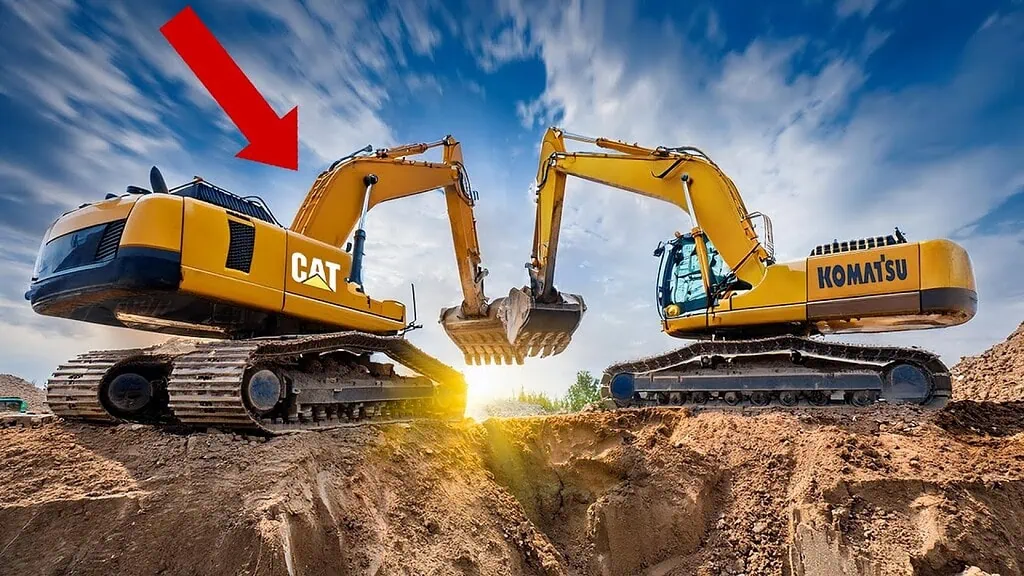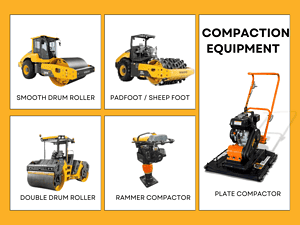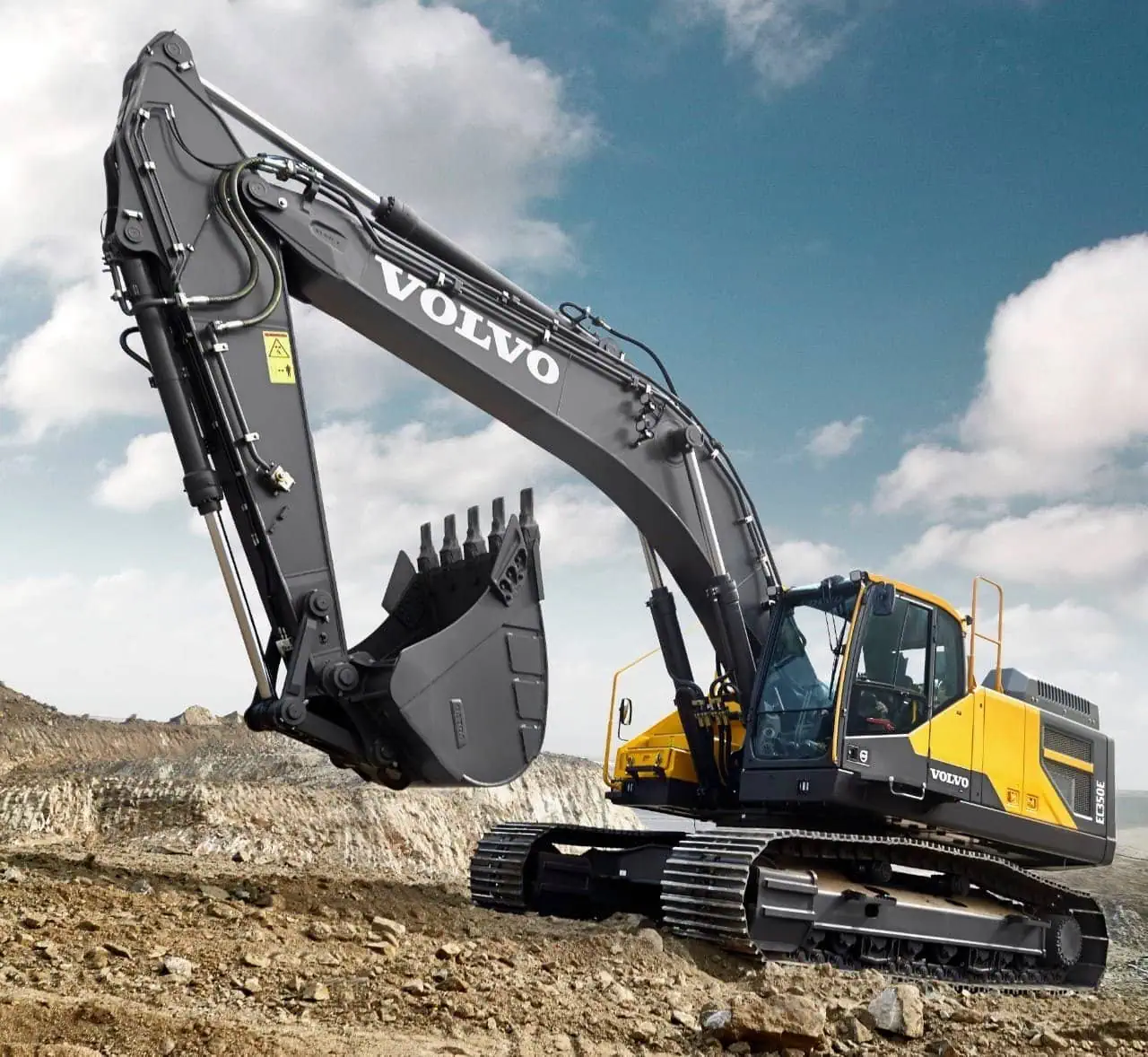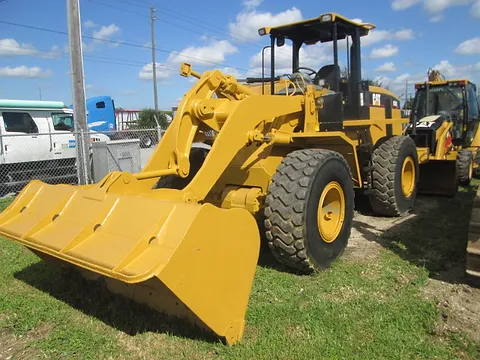Struggling with high fuel costs on your construction projects? Choosing an excavator with exceptional fuel efficiency can dramatically reduce your operational costs. In our Komatsu vs CAT excavator comparison, we’re looking at which brand offers better fuel efficiency to help you make an informed, cost-saving decision for your next project.
When selecting an excavator for your project, fuel efficiency plays a crucial role in reducing long-term operational costs. Komatsu vs CAT excavators both offer advanced technologies designed to optimize fuel use. Komatsu excels with its Economy Mode and Tier 4 engines, while CAT focuses on energy-efficient systems and C9.3B engines. This article compares both brands’ fuel consumption, performance, and environmental impact, providing essential insights to help you choose the right machine based on fuel savings, maintenance, and overall cost-effectiveness.
You understand the importance of fuel efficiency now, where we hope you can. Let’s dive into the nuts and bolts of each brand and each machine so you can see which offers better fuel efficiency in this size class.

Оглавление
ПереключатьOverview of Fuel Efficiency in Excavators
Fuel efficiency is the measure of how a machine uses less fuel to do its job, which results in savings and is better for the environment. For you, the business owner, fuel burn is one of the most important—sometimes the most important—drivers of your total cost of ownership (TCO) for a piece of equipment. Also, understanding the role fuel efficiency plays in the overall performance of a machine is critical. Because with a machine that uses less fuel, you can build anything at a lower cost to you, especially with large machines where the iron’s thirst is a big deal on your monthly burning report.
Fuel Efficiency’s Role in Project Costs
Fuel efficiency isn’t just about how much fuel an excavator burns. It’s about how well a machine uses consumption, such as designing hydraulic systems that don’t take as much energy. That’s not the best way to say it, but you understand—using the fuel to create the hydraulic pressure in a more efficient manner. Both Komatsu and CAT use technology within their machines in an attempt to lower the amount of fuel burned. Both companies have a different approach to how they attack the problem, but let’s look at what they’re doing to save you fuel.
Komatsu Excavators and Fuel Efficiency
Likewise, Komatsu does a great job of stuffing technology into their machines. They have a fantastic focus on being green, and Komatsu will add technology to a machine to reduce fuel burn. It’s a win-win. Get the best fuel economy today, and the company you are selling to gets the best fuel economy over the life of the machine.
Key Features of Komatsu Excavators for Fuel Efficiency
Economy Mode
Komatsu’s Economy Mode optimizes the engine’s power output based on the load demand, ensuring that fuel is used more efficiently during less demanding tasks. For instance, light digging or moving material across short distances doesn’t require full engine power, allowing the machine to consume less fuel.
Advanced Hydraulics
Komatsu’s advanced hydraulic systems reduce power losses during operation, allowing the machine to do more work using less fuel. The use of variable-displacement pumps in many models further contributes to better fuel efficiency.
Tier 4 Engines
Komatsu’s Tier 4 Final engines meet strict emissions standards and are specifically designed to reduce fuel consumption. These engines adjust the fuel output based on the load, ensuring that the machine only uses as much fuel as necessary.
Komatsu Excavator Fuel Consumption Breakdown
| Komatsu Model | Fuel Consumption (L/h) | Fuel Efficiency Features | Typical Use |
| PC360LC-11 | 19-22 L/h | Economy Mode, Tier 4 Engine | Heavy-duty Construction |
| PC220-8 | 17-20 L/h | High-efficiency Hydraulics | Medium Duty Projects |
| PC490LC-11 | 24-27 L/h | Variable-displacement pump | Heavy Duty Operations |
| PC78US-10 | 12-15 L/h | Economy Mode, Efficient Hydraulics | Small to Medium Projects |
Komatsu’s PC360LC-11 and PC220-8 are examples of machines that stand out with their Economy Mode setting to reduce fuel consumption and for their Tier 4 engines. While handling more minor tasks, they save on fuel during times they don’t necessarily need full engine power.

CAT Excavators and Fuel Efficiency
For over a decade, Caterpillar (CAT) has been committed to delivering tough, reliable machines that can handle the most demanding applications our customers can throw at them. That’s what Caterpillar hydraulic excavators are known for — long life, big power, hard work, and all the performance you demand. Not only does CAT put fuel-saving engine technology in every one of their hydraulic excavators, they put it to use. Each is purpose-built to put every ounce of that power and energy-saving performance to work for you, to put more money in your pocket at the end of the day.
Key Features of CAT Excavators for Fuel Efficiency
C9.3B Engines
The extremely fuel-efficient C9.3B Engines provide the power you need and a torque curve for maximum performance. They also automatically adjust output to match the load demand, saving fuel under lighter load conditions. Yet when you want every ounce of performance these excavators can deliver, they’ll never let you down. They’ll even save you money by using less fuel.
Energy-Saving Hydraulic Systems
Energy-saving hydraulic systems reduce fuel expense by making sure you don’t lose any power unnecessarily between the engine and your tracks or attachments. Instead, every drop of that fuel goes to work for you.
Optimally Efficient Machine Designs
Again, every aspect of a Cat excavator is designed to reduce your fuel bill. Clever engineering for efficient materials, creative designs that help slice through the wind, smart engine layouts that need less fuel to do their work, and the ability to do it all at higher speeds with less trouble than you’d ever imagine all add up to improved fuel efficiency when you’re on the move.
CAT Excavator Fuel Consumption Breakdown
| CAT Model | Fuel Consumption (L/h) | Fuel Efficiency Features | Typical Use |
| CAT 336 GC | 18-21 L/h | C9.3B engine, Energy-saving hydraulics | Heavy-duty Construction |
| CAT 320 | 17-19 L/h | Fuel-efficient engine, low maintenance | Medium Duty Projects |
| CAT 349 | 22-25 L/h | Optimized hydraulic systems, C9.3B engine | Heavy Duty Operations |
| CAT 315GC | 13-16 L/h | C9.3B engine, Eco-friendly hydraulic design | Light to Medium Operations |
The CAT 336 GC is a very fuel-friendly machine specifically because it has the C9.3B engine and an energy-saving hydraulic system, so you can run it wide open and get all the work you need done, just like it’s nobody’s business!

Fuel Efficiency Comparison: Komatsu vs CAT Excavator
Let’s dive into the direct comparison between Komatsu and CAT excavators in terms of fuel consumption, highlighting the differences in engine technologies and overall efficiency.
Fuel Efficiency Comparison Table: Komatsu vs CAT
| Excavator Model | Бренд | Fuel Consumption (L/h) | Fuel Efficiency Features | Typical Project Type |
| PC360LC-11 | Комацу | 19-22 L/h | Economy Mode, Tier 4 engine | Heavy-duty Construction |
| CAT 336 GC | КОТ | 18-21 L/h | C9.3B engine, Energy-saving hydraulics | Heavy-duty Construction |
| PC220-8 | Комацу | 17-20 L/h | High-efficiency hydraulics | Medium-duty Projects |
| CAT 320 | КОТ | 17-19 L/h | Fuel-efficient engine, low maintenance | Medium-duty Projects |
| PC78US-10 | Комацу | 12-15 L/h | Efficient Hydraulics, Economy Mode | Small to Medium Projects |
| CAT 315GC | КОТ | 13-16 L/h | C9.3B engine, Eco-friendly hydraulic design | Light to Medium Operations |
These two machines consume fuel nearly identically, plus the Komatsu has an advantage in light to medium work thanks to an Economy Mode. The Caterpillar comes out ahead in the heavy-duty column with its bulletproof C9.3B engine.

Factors Affecting Fuel Efficiency in Excavators
There can be additional factors beyond engine type and hydraulic systems with your excavator that affect fuel economy. Let’s look at some of the external factors that can really help (or hinder) your bottom line:
Project Type and Task Intensity:
If you’re using an excavator in a heavy-duty environment – like a city job, mine, or for demolition work – you’re going to burn more fuel. Fortunately, the more advanced fuel-saving features in machines like the Komatsu and the Caterpillars help offset that added cost.
Task Load:
If you’re running any kind of lightweight system like a landscape excavator or shallow digging system, you’re not going to burn as much fuel as if you’re up doing heavy lifting or digging trench deep in the ground.
Terrain and Working Conditions:
It doesn’t take a rocket scientist to know that if your machine is working against gravity all the time (like on a slope) and trying to chew through hard, rough ground, you are going to consume a lot more fuel than if you’re running a CAT 349 or a Komatsu PC490LC-11 on flat, dry, easy ground.
Method and Frequency of Machine Maintenance:
The better shape your machine is in and the less energy it has to spend working against clogged systems like an air-breathing filter restrictor, an oil system clogged by dirty oil filters, or a hydraulic system that won’t transfer power – the less fuel your machine is going to consume.
Here’s a table illustrating how terrain type and workload intensity impact fuel consumption:
Fuel Efficiency vs Terrain and Workload
| Terrain/Workload Type | Fuel Consumption Increase | Recommended Excavator Models |
| Flat Terrain, Light Work | 0-10% increase | Komatsu PC220-8, CAT 320 |
| Rough Terrain, Medium Work | 10-20% increase | Komatsu PC360LC-11, CAT 336 GC |
| Heavy Lifting, Deep Digging | 20-40% increase | Komatsu PC490LC-11, CAT 349 |
As you can see in the table, task and terrain can significantly affect your fuel burn, but if you do a good job picking the right machine with the right features to minimize those extra fuel burns, you’re sitting pretty.
Real-World Fuel Efficiency Performance in Projects
In terms of your fuel cost per hour, it can vary based on the project you’re doing, the fuel consumption of the model you bought, and how you operate the machine. Below are general fuel-burn numbers for a couple of different machines from Komatsu and Caterpillar.
Komatsu PC360LC-11
Komatsu PC360LC-11 Example: During road construction projects, a comparison of an older model Komatsu to the PC360LC-11 resulted in a 15 to 20 percent fuel consumption savings using the new machine. The two reasons it performed so well include the Economy Mode, which adjusts the engine’s power for less strenuous tasks, burning less fuel to do the same job over the course of a day. The second reason is the brand-new, amazing hydraulic system on this machine transfers energy slightly better and burns less fuel than their previous technology.
Komatsu PC360LC-11: Fuel Efficiency Performance
| Feature | Спецификация |
| Project Type | Road Construction |
| Fuel Savings | 15-20% Reduction in Fuel Consumption |
| Fuel-Efficient Technology | Economy Mode, High-Efficiency Hydraulics |
| Fuel Consumption (L/h) | 19-22 L/h |
| Key Efficiency Benefit | Reduced fuel use in lighter tasks due to Economy Mode |

CAT 336 GC
CAT 336 GC Example: In a heavy-duty mining operation, CAT had a customer compare an older machine to the new CAT 336 GC. They were saving 10 to 15 percent on their fuel costs due to two main things. First, the C9.3B engine in this GC model is designed to use less fuel than their old engines. The second reason is this brand-new hydraulic system saves energy and transfers that energy better, resulting in burning less fuel, even when that machine is being dragged through the mud day-in and day-out on a mining project.
CAT 336 GC: Fuel Efficiency Performance
| Feature | Спецификация |
| Project Type | Heavy-Duty Mining |
| Fuel Savings | 10-15% Reduction in Fuel Consumption |
| Fuel-Efficient Technology | C9.3B Engine, Energy-Saving Hydraulics |
| Fuel Consumption (L/h) | 18-21 L/h |
| Key Efficiency Benefit | High fuel efficiency even in demanding tasks |
Komatsu vs CAT Excavator: Which Brand Is More Cost-Effective for Fuel Consumption?
When you start talking about your fuel cost difference over time, you need to understand how many several-hour days there are over the lifetime of a track machine. You may see 30,000-50,000 hours of use or more over a 10 to 15-year period. You will burn a lot of fuel, so this is a super critical part of the decision you make when purchasing a Komatsu or a CAT.
Fuel Cost Breakdown: Komatsu vs CAT
Let’s break down the expected fuel costs over the span of 1-5 years for both Комацу and CAT excavators. This comparison considers the average fuel consumption for both brands, along with annual operational hours.
Annual and Long-Term Fuel Cost Comparison
| Бренд | Fuel Cost per Hour | Annual Fuel Cost (1,000 hours) | 5-Year Fuel Cost | Expected Savings (vs. CAT) |
| Комацу | $10.50 | $10,500 | $52,500 | $4,000 |
| КОТ | $11.00 | $11,000 | $55,000 | – |
From this table, it’s evident that Комацу offers an advantage in fuel savings, with an expected $4,000 savings over a 5-year period when operating for 1,000 hours per year.
Why the Cost Difference?
The reason Komatsu tends to save a little more over time is they tend to burn less fuel every time you operate them because the engine uses less fuel , which directly translates into you burning less fuel. CAT is also super-tough and will run forever. However, they dial in the machine to have a little more performance when you are in those really severe, heavy-duty conditions. Because of that, they drink a touch more fuel when doing that hard work.
Komatsu vs CAT Excavator: Which Brand Is Better for Environmental Sustainability?
Emissions Standards and Environmental Compliance
Both brands meet Tier 4 Final emissions, which means they comply with EPA regulations of how much exhaust they can produce , how much particulates can come out, and so on. Each does it a little bit differently, but the end result is the same. You meet the emissions, and the machine isn’t smoking or belching black soot out of the exhaust stack.
Sustainability Comparison: Komatsu vs CAT
| Feature | Комацу | КОТ |
| Tier 4 Final Compliance | Да | Да |
| Fuel-Efficient Engine | Yes (Economy Mode, Tier 4) | Yes (C9.3B Engine, Energy-saving) |
| Emission Reduction Features | Low emissions, Eco-mode | Low emissions, Regenerative system |
| Sustainability Certification | ISO 14001 | ISO 14001 |
Both of them have obtained their ISO 14001 Certification, so that is a big deal as the company has gone through a rigorous process to make sure they are doing everything they possibly can to protect the environment. One of the number one ways to protect the environment is to burn less fuel. That is one of the great things that you get from both companies with their machines that they have built to meet the Tier 4 standards with a regenerative system in the case of the CAT excavator and an Economy Mode in the case of our Komatsu.
Innovations in Fuel Efficiency and Sustainability
Komatsu: The Komatsu has an Economy Mode where it automatically throttles down to a lower speed, which causes you to burn less fuel, which saves you money, which is obviously good for the environment because
you are producing fewer emissions. Additionally, the way the advanced hydraulics work on the Komatsu machines is another way Komatsu is trying to reduce the impact on the environment.
КОТ: They are really concentrating on being energy-efficient, and that is the whole reason for the C9.3B. They have regenerative features built into it. The idea is to burn less fuel and also produce fewer harmful gases out of the exhaust stack as the machine operates.
Заключение
When comparing Komatsu vs CAT excavators, both offer excellent fuel efficiency. However, the choice between the two depends on your project’s specific needs:
Комацу excels at providing fuel efficiency for medium to light tasks, especially with its Economy Mode and advanced hydraulics.
КОТ is best for heavy-duty applications, where the robust C9.3B engine and optimized hydraulics deliver consistent fuel efficiency under tough conditions.
Ultimately, Комацу may be the better choice for long-term fuel savings, while КОТ shines in heavy-duty applications.
Follow us on :YouTube.










